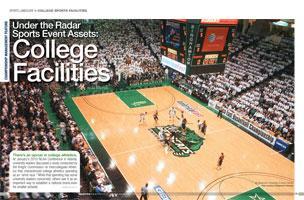
There's an uproar in college athletics. At January's 2010 NCAA Conference in Atlanta, university leaders discussed a study conducted by the Knight Commission on Intercollegiate Athletics that characterized college athletics spending as an "arms race." While that spending has some university leaders concerned, others see it as an important way to establish a national brand even for smaller schools.
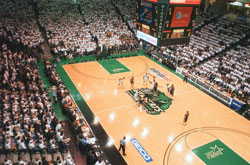 |
| Binghamton University Events Center. Photo courtesy of Binghamton University. |
No matter which side of the argument you agree with, one thing is for certain: for sports event planners, the explosion in athletics spending is a benefits boon. College athletics are big, and that has resulted in big spending on some extraordinary new facilities. And what better way for colleges and universities to recoup their spending than by becoming exceptional hosts for your next sporting event? Take a tour of a few of the country's best new higher education places to play.
Big Spending, Better Facilities
According to the Knight Commission study, "a construction boom has echoed throughout intercollegiate athletics as programs have upgraded existing and created new facilities." The NCAA's Presidential Task Force on the Future of Intercollegiate Athletics reported in 2005 that nearly 20 percent of current athletic spending on average is tied to facility expansion and capital debt. While recruiting costs only account for 2 percent of budgets, some athletics leaders argue that facilities spending should be considered a recruiting expense since, as the Knight Commission study puts it, "athletics programs woo 17- or 18-year-old high school seniors with the most lavish practice facility, shiniest academic study center or snazziest arena."
Whether you support athletics spending or not, the fact is, the colleges are building the facilities,and they're hoping the sports events will come. Fortunately, that means sports event planners have at their fingertips the biggest selection of the most high-tech, first-rate facilities in history all across the country. All it takes is a little research to find out which facility is the right fit for your event.
West Michigan
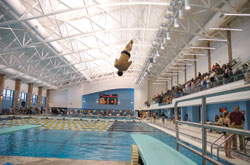 |
| The Calvin College natatorium. Photo courtesy of West Michigan Sports Commission. |
America has a lot of college towns. You know the places-communities that have grown up around a college or university, quiet in the summers, raucous in fall, and usually blessed with more than their fair share of coffee shops. But there are some places in America that are more than just college towns. They're college collections. Not only do these towns have multiple colleges, they also have access to a wealth of sports facilities. That makes these communities-places like West Michigan-a great place to turn when you're planning your next event.
"We're working with a couple of different athletic conferences, the National Association of Intercollegiate Athletics (NAIA) and the NCAA," says Mike Guswiler, executive director, West Michigan Sports Commission. "We've got a number of very strong schools in the area. They really see the value in offering exceptional sports facilities, and they're great partners."
In 2008, Davenport University opened a $15.6 million, 87,000-square-foot University Student Center that features an auxiliary gym, offices, meeting rooms and a 1,500-seat field house. Davenport is home to several other athletic facilities as well, including a new turf field and Patterson Ice Center, a two-sheet,NHL and Olympic, facility, with a 5,000 square-foot lobby overlooking both sheets. West Michigan's premier facility for figure skating, hockey and speed skating, the Center hosted more than 400 athletes at the 2009 U.S. Adult Figure Skating Championships.
Davenport isn't West Michigan's only institution of higher learning upgrading its athletic facilities. Aquinas College is building a$12 million field house, expected to open in 2012, while Cornerstone University's Bernice Hansen Athletic Center was completed in March 2001, with 125,000 square feet of space housing Mol Arena, four classrooms, a field house/practice gym, jogging track, six locker rooms, conference room and office space.
 |
| Carnie Smith Stadium on the campus of Pittsburg State University. Photo courtesy Malcolm Turner/PSU Public Relations. |
In 2008, Division II school Grand Valley State University (GVSU) opened the Laker Turf Building, an $18 million, 138,000 square-foot, Gold LEED certified facility with a six-lane, 300 meter indoor track with nine sprint lanes and a 100-yard indoor sport turf field. And in 2009, Calvin College, a Division III school, opened a $50 million, 345,000-square-feet athletic facility that includes a 5,000-seat arena, four tennis courts and an Olympic-size pool.
Binghamton,New York
Binghamton, N.Y., is accustomed to being at the center of things, as both an important historical railroad hub and the birthplace of IBM. Now, as the home of Binghamton University and its sports facilities, the town is the center of some major sports events, as well.
Offering a full range of facilities, including a 156,000 square-foot, 5,142-seat arena, 8,000 and 5,000 meter cross country courses that run through the Binghamton Nature Preserve, a two-field soccer/lacrosse complex with synthetic turf, baseball and softball fields, a state-of-the-art aquatics center, and an eight-lane 400 meter track and field stadium, Binghamton is the ideal location for multi-sport events. Fortunately, Binghamton has not just the facilities to make these events succeed, but also the experience.
"We've partnered with Binghamton to host a number of events, including the Empire State Games, a regional Olympic-style competition with 27 different sports, and the Special Olympics Summer Games," says Judi Hess, manager of tourism and special events, Greater Binghamton Convention and Visitors Bureau.
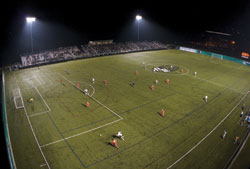 |
| Binghamton University Bearcats Sports Complex. Photo courtesy of Binghamton University. |
Binghamton is also home to Broome Community College (BCC),located only 10 miles from the University, an asset when planning these multi-sport events. BCC is a member of the National Junior College Athletic Association (NJCAA) and home to a variety of facilities, including two large, fully-equipped gymnasiums, baseball field, soccer/lacrosse complex, six tennis courts and the BCC Ice Center, a 758-seat hockey arena.
Butler County, Ohio
Butler County is already a haven of fine sports facilities, but add to that the extensive event-hosting capacity of Oxford's Division I Miami University, and you've got a candidate for sports paradise. Host of this year's Mid-American Conference (MAC) women's swimming championship, Miami's $22 million Recreational Sports Center houses the Corwin M. Nixon Aquatic Center, offering an eight-lane, 50-meter pool and a separate 25-meter well, containing one-, five-, seven- and 10-meter platforms.
The Corwin M. Nixon Aquatic Center is just one of the University's many fine athletic facilities, which also include the 24,286-seat Fred C. Yager Stadium, recently renovated and in its 26th season; $7.5 million, 9,200-seat Millett Hall, home of RedHawk men's and women's basketball and volleyball; and the new Goggin Ice Center, a two NHL-sheet facility that seats 3,200, including 2,800 reserved lower-bowl seats, 102 club seats, four opera boxes and six private suites.
"Miami is an outstanding university, both academically and athletically," says Stephanie Gigliotti, sales manager, sports and events, Butler County Visitors Bureau. "They've got a lot of new, great facilities that have come into use in the past five to ten years, which is a real asset."
Crawford County, Kansas
"The fact is, we've got a ton of great college facilities here," says Craig Hull, director, Crawford County Convention and Visitors Bureau. And that just about says it all.
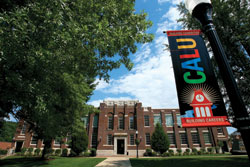 |
| California University of Pennsylvania. Photo courtesy of California University of Pennsylvania. |
Division II Pittsburgh State University calls Crawford County home, and so do its facilities, including Carnie Smith Stadium, an 8,500 square-foot facility that can accommodate up to 10,000 spectators. With the largest video board in Division II football, Carnie Smith Stadium easily fits the definition of state-of-the-art.
"It's amazing to be able to have [Carnie Smith Stadium] as your showcase venue," says Hull. "When sports organizations look at us, at first they think, here's a small town in southeast Kansas. But then I roll this facility out that blows them away."
Carnie Smith Stadium hosted the 2009 NJCAA national championship at the inaugural Citizen's Bank Bowl, an event that will return to Pittsburgh State in 2010.
Pitt State, as the school is affectionately known, is also home to Prentice Gudgen Track, named for the school's legendary coach and athletic director who led the University to win five conference titles in a six-year span (1953-58). The facility features a polyurethane track and long jump, triple jump and pole vault runways, as well as javelin and shot put stations, all installed in 2003.
California University of Pennsylvania
Just 30 miles south of Pittsburgh, a sports oasis sits right on the banks of the Monongahela River. For more than 150 years, California University of Pennsylvania has maintained a reputation for academic excellence, but the school also has another reputation to uphold, one for exceptional athletic facilities, and its newest project is just another feather in that cap.
"We have tons of really great existing space and facilities on our campus," says Juanita Timney, executive director, University Conference Services, California University of Pennsylvania. "But this past August, we broke ground on a $54 million convocation center. When it opens in the fall of 2011, it will take us to a whole new level in terms of hosting athletic events."
To accommodate the needs of event planners who take advantage of the University's new facilities, the school has assembled a team of four full time meeting planners, one of whom is dedicated solely to sports and the many academic camps that use the University's residence halls, all new within last three to five years.
Sports camps are a big deal at California University, filling the campus with soccer, track and field, cross country, cheer and dance, volleyball, basketball and tennis camps, as well as a variety of sports clinics, throughout the summer. To accommodate all these events and the athletes who attend them, the University maintains an array of excellent facilities as well.
Hamer Hall is the home to California's 3,500-seat varsity arena, natatorium, weight room, training room and classroom space. Adjacent to the main arena, the first floor includes 10 locker rooms and the main athletic equipment room. California's six-lane, 25-yard competition pool also has several locker rooms, new scoreboards and record boards and gallery seating for 250. The facility also features a concession stand and a physical therapy facility.
Adamson Stadium is the University's home for football and track and field, featuring an eight-lane, all-weather track, renovated in 2002, a two-level press box that can accommodate radio and television broadcasts, two large varsity locker rooms, two sets of public restrooms, concession stand, scoreboard with message board capabilities and a training room.
Columbus, Ohio
When you bring up college sports facilities in Columbus, Ohio, the outstanding Division I facilities at Ohio State University are sure to come up first, but that's not all Ohio's largest city has up its sleeve.
"Right now we're working on state high school football championships, which would be held at Ohio Stadium," says Jeffrey John, sales manager, Greater Columbus Sports Commission. "It's pretty exciting because it would give the opportunity to play in the state's best football stadium."
That stadium, resting alongside the Olentangy River, is the home of the Ohio Buckeyes. Built for $1.3 million in 1922 and refurbished in 2001 for slightly more than $194 million, the horseshoe-shaped stadium seats 102,329, making it the fourth largest on-campus facility in the nation.
But don't overlook central Ohio's other colleges and universities, such as Capital University, home to the Capital Center, a 126,000-square-foot recreational and athletic complex that includes a 2,100-seat arena, 3,000-seat Bernlohr Stadium, 51,000-square-foot multipurpose forum. Nearby, Ohio Dominican University is home to Panther Field, built in 2004, which is equipped with a SprinTurf surface, seats 1,750 and offers a 42-foot press box.
Facilities with a Higher Purpose
College athletics have become a very big business in recent decades, and the debate will rage on about how much athletic spending is truly appropriate and sustainable. But all arguments aside, these facilities offer universities, and the communities that they call home, an incredible asset, a way to connect with their students and citizens, and, above all, a place to play.

